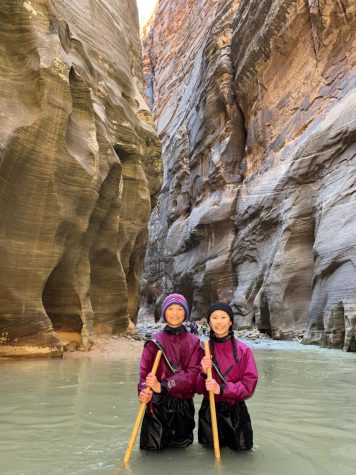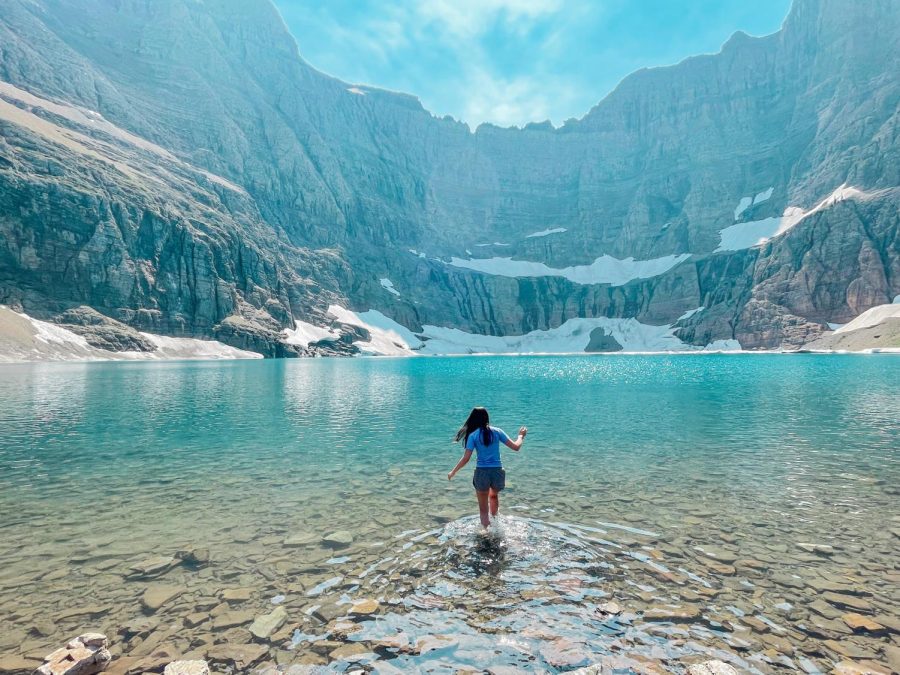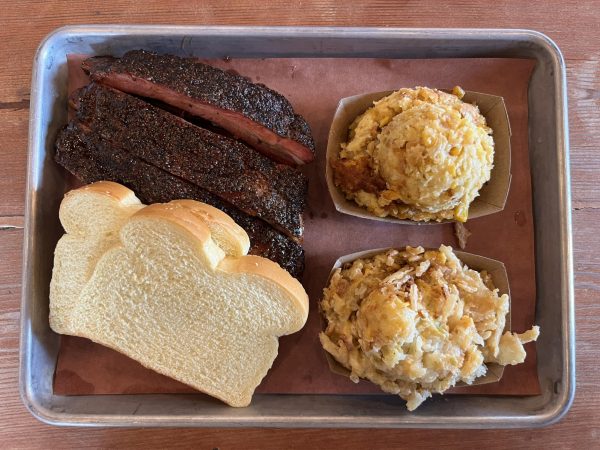5 national parks to add to your bucket list
Chen reaches the final destination of the eleven-mile Iceberg Lake trail in Glacier National Park. Hikers can walk a few feet into the 30 degree melted glacier water, or they can opt to wade several feet in and submerge themselves completely.
A vacation with my family is not like any other. My family is hardcore and whether that means waking up at 6 a.m., sleeping at 11 p.m. or skipping lunch to hike, we do it all for one reason: our national parks bucket list.
When the pandemic hit in spring 2020, my family began searching for ways to travel safely. Now less than a year and a half later, we’ve traveled to 31 national parks across the country, from Haleakalā in Hawaii to Dry Tortugas, an island off the coast of Key West only accessible by a two-hour seaboat ride.
Although we are worn out after every trip, the pictures and memories remind us of the beauty you can’t find anywhere else. Each park I’ve visited boasts its own unique features, but five parks have especially earned my recommendation. Here are my five “must-see” parks.
5. Biscayne National Park, Florida Keys
Biscayne is home to some of the best snorkeling you can find in the United States. After taking a boat several miles past the shoreline, you can snorkel and spot a wide variety of sea life including dolphins, stingrays, sea turtles and many species of fish. The mangrove forest stretching along the coastline is the perfect place for a peaceful kayak ride in its still waters. As we paddled along for two hours, our tour guide pointed out sea turtles as they glided past our paddleboards. We also hopped off our paddleboards to snorkel, spotting a rainbow-colored assortment of fish and lobsters weaving their way through the thick roots of the mangroves. However, you should be sure to bring lots of Dramamine. It is hands down the only way I was able to survive the choppy waters of the deep ocean.
4. Yellowstone National Park, Wyoming
Yellowstone was the second most-visited national park last year and for good reason. As America’s largest park, it includes geysers, hot springs, mountains and waterfalls. There are many excursions available to the public, and my family and I went fishing on the lake and rode on horseback through the park. Known for its wildlife, seeing bears, elk and bison quickly became a daily occurrence. While driving through the park, we frequently pulled over beside a long row of cars to watch baby bears and their mom crawl through the woods. The park is also home to Beaver Ponds, one of the scariest trails I’ve hiked and a hotspot for bear sightings. Along the entire five-mile trail, my family did not come across a single other hiker. I remember us blasting the Hamilton soundtrack, shaking our bear bells and nervously grasping our bear spray in an attempt to prevent us from surprising an unsuspecting bear. Only weeks after we left, someone was mauled by a bear on the exact same trail and seriously injured. However, as long as you are prepared to defend against bears, hiking the park is a carefree experience. One final bonus of Yellowstone is its location, making it the perfect place to start a road trip tour, which can include the Badlands, Mount Rushmore, Wind Cave and Bear Country.

3. Zion National Park, Utah
Zion is my favorite of Utah’s “Mighty Five” and is home to one of the most memorable trails I’ve hiked – not Angel’s Landing, but the Narrows, a full day 10-mile hike through chest deep water between the canyon walls. After suiting up in special wetsuits designed to keep out the freezing water, my family and I began the trek, pushing against the current on the way there and floating back to the trailhead on our backs. The uneven stones lining the canyon floors made it hard to wade through the water, and each of us left with bruised knees and shins that served as a reminder of our countless falls. If you’re looking for a less intense hike, Observation Point trail offers an easy, scenic 7-mile hike that leads to an overlook of the entire park, including the iconic Angel’s Landing trail and the tiny dots of hikers scaling the steep mountain. After staying at the lookout for sunset, my family and I rushed down the mountain in complete darkness, holding our phone flashlights to make sure we didn’t trip over a stray branch. The drive through the park even provides spectacular views from your car of multicolored mountains and canyons. Although I didn’t find the rest of the trails to be anything out of the ordinary, it’s worth making a trip just for Angel’s Landing, the Narrows and Observation Point. Avoid going during the summer as extreme temperatures and dehydration guarantee an unenjoyable experience.
2. Crater Lake National Park, Oregon
Not only is Crater Lake the deepest and clearest lake in America, it is also one of the most underrated parks. Its large number of trails range in difficulty from a breezy 2-mile observation trail to a much more strenuous trail that ends with an opportunity to jump off a cliff into the refreshing water below. This 35-foot jump from the Cleetwood Cove Trail isn’t too high or dangerous, making it a safe experience for the entire family. Once in the water, you can swim and relax before climbing up 700 feet in a .5-mile span. Although I wouldn’t consider myself an adrenaline lover, I was eager to jump multiple times into the chilling 50° water below. It’s a great place to have a picnic and take spectacular pictures. The only downside to this trail was the long line of people waiting who spent an eternity on the cliff’s edge attempting to muster up enough courage to jump. If you forget a change of clothes, Discovery Point Trail is a much milder trail that allows you to circle a small portion of the lake. Crater Lake is the most beautiful lake I’ve visited, and pictures can’t truly capture the vibrance of its water.

1. Glacier National Park, Montana
Finally, Glacier National Park is the most spectacular park I have visited. The landscape is composed of lakes, mountains, river rapids, forests and most importantly: glaciers. Many trails are pretty much guaranteed wildlife sightings, and it’s common to see a large group of mountain goats or bighorn sheep walk across the path just a few feet ahead of you.
Mount Oberlin trail is a hidden gem in the park, ending with a rockslide scramble and leading my family and I right to a large herd of 30 or so bighorn sheep. Without a doubt, Mount Oberlin trail is home to my family’s scariest encounter with wildlife. As we attempted to scale down the steep rock piles making up the trail, we watched behind us as curious Rocky Mountain bighorn sheep bounded down the mountain with ease. Our hearts and minds were racing as we gripped our hiking sticks and prepared to use them as swords in a last resort. Thankfully, we made it out alive, and the encounter is now one of my most memorable experiences.
To take a break from the hiking, we also went on a white water rafting tour, which I would highly recommend. Not only does it provide you with spectacular views, there is even an opportunity to hop out of the raft and swim in the freezing water.
Iceberg Lake trail, the most popular trail in the park, is 11 miles long, providing very little shade and no bathrooms along the way, but the final destination is worth the trek, dropping you right up to a pristine alpine lake full of floating icebergs. Hikers can change into swimsuits and dive into the melting glacier water for a chilling swim in water that is usually 30 degrees or colder. I was only able to wade in to my knees before I felt like my legs would fall off, but other hikers, including my dad, opted for a full body swim. Some daring adventurers even swam across the wide lake to hop from one floating glacier to the next.
Overall, I would recommend everyone to travel to at least one of these five parks. Whether you choose to follow an overflowing itinerary or opt for a slow-paced, peaceful trip, the sightseeing is guaranteed to create memories that will last a lifetime. The beauty of nature in these parks is unmatched, and similar opportunities for excursions and spotting wildlife are hard to find.
My family plans to visit all 53 parks in the continental US before I graduate high school, and our bucket list resumes as we head to California’s parks over Spring Break.
Your donation will support the student journalists of Bellaire High School. Your contribution will allow us to purchase equipment and cover our annual website hosting costs.








wow • Mar 20, 2022 at 5:55 am
nice